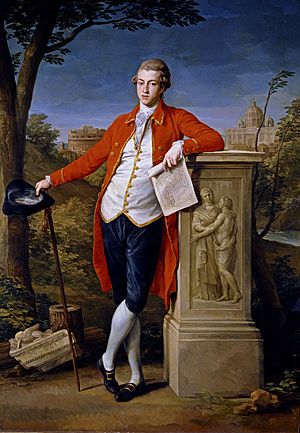Grand Tour facts for kids

The Grand Tour was a special trip across Europe that rich young men, mostly from Britain, took a long time ago. It happened between about 1660 and 1840. The main idea was for these young men to learn about European art, history, and different societies. People believed that what they learned on this trip would help them become better leaders and citizens when they returned home. Italy was often the most important country to visit. These travelers usually went with their servants and a private teacher, sometimes called a bear-leader.
Contents
What Was a Grand Tour Like?
The exact places visited on a Grand Tour changed over the years. But here's an example of what a British traveler's journey might have looked like:
Starting the Journey
A traveler would usually start from Dover, England. They would cross the English Channel by boat to places like Ostend in Belgium, or Calais or Le Havre in France.
Once they arrived, they could rent or buy a carriage to travel to Paris. Some might even travel by boat up the Seine River to Paris, or up the Rhine River to Basel.
Learning in Paris
In Paris, the capital of France, young travelers would often take lessons. They might learn French, dancing, fencing, and horse riding. Paris was very popular because of its stylish society and the chance to learn the French language, which was very important at the time.
Crossing the Alps
From Paris, the journey would often continue to Switzerland, perhaps to a city like Geneva. After Switzerland, the travelers faced a challenging trip over the huge Alps mountains to get into northern Italy.
Discovering Italy
Once in Italy, the first stop might be Turin. Many travelers would then spend a few months in Florence, a city famous for its art. They would often meet other Grand Tourists there. After Florence, they might visit Pisa, then move on to cities like Padua, Bologna, and Venice.
Venice was considered a very important place to visit, especially for studying Italian architecture and its unique buildings.
Rome and Beyond
From Venice, the next big stop was usually Rome. Here, travelers would spend time studying the amazing ruins of ancient Rome, learning about its history and art. Some also went to Naples to study music. Naples was often the furthest point of the tour before the journey back home began.
The Return Trip
After Italy, the traveler would head north again, crossing the Alps into the German-speaking parts of Europe. From there, they might visit Holland and Flanders (parts of modern-day Belgium and the Netherlands) before finally crossing the English Channel back to England.
Images for kids
-
This painting shows Douglas, 8th Duke of Hamilton, on his Grand Tour with his doctor, Dr. John Moore, and Dr. Moore's son, John. In the background, you can see Geneva, where they stayed for two years. Painted in 1774.
-
This picture shows the ruins of the Acropolis in Greece. It's from Mark Twain's own "grand tour," a five-month trip across Europe, the Middle East, and the Holy Land. He wrote about it in his funny book Innocents Abroad (1867).
See also
 In Spanish: Grand Tour para niños
In Spanish: Grand Tour para niños






